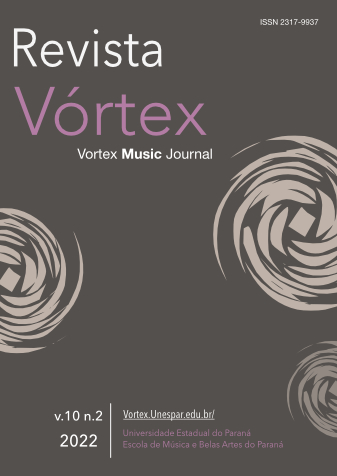A new derivation shows Schubert learning thematic work from a Beethoven sonata
DOI:
https://doi.org/10.33871/23179937.2022.10.2.7098Palabras clave:
Schubert, Beethoven, derivation, theme, sonata-allegro formResumen
A newly discovered derivation of Schubert from Beethoven is presented: the piano sonata in B major D.575 IV from the piano sonata in A-flat major Op.26 II. A method for finding thematic derivations is first outlined. The present derivation shows Schubert learning to compose thematic material by following Beethoven’s example. The article increases our knowledge of Schubert after his early mastery of vocal composition, as he earnestly worked to learn the piano solo side of his craft. He needed to master three main areas: logical manipulation of abstract musical material rather than text-based expression, sonata-allegro and related forms rather than song forms, and writing for the physical technique of solo piano performance rather than for voice with piano accompaniment. He had apparently received little or no training in those areas, and it is very instructive to see him making his own way.
Descargas
Citas
CHO, Sookkyung. Schubert’s Sonata in B major, D. 575, Reimagined. DMA thesis, Juilliard School of Music, 2013.
CONE, Edward T. Musical Form and Musical Performance, New York: Norton, 1968.
EPSTEIN, Julius (ed.). Franz Schubert’s Werke. Kritisch durchgesehene Gesammtausgabe. Series 10 No. 5. Leipzig: Breitkopf und Härtel, 1888. [Plate F.S. 97].
KÖLTZSCH, Hans. Franz Schubert in seinen Klaviersonaten. Leipzig: Breitkopf & Härtel, 1927. Reprinted Hildesheim & New York: Georg Olms, 1976. An English translation (Franz Schubert in his Piano Sonatas) is in preparation by the present author.
NETTHEIM, Nigel. “The Derivation of Chopin’s Fourth Ballade from Bach and Beethoven”. The Music Review, Vol. 54 No. 2, 1993, p. 95-111.
NETTHEIM, Nigel. “How the Young Schubert Borrowed from Beethoven”. The Musical Times, Vol. 132 No. 1781, July 1991, p. 330-331.
NEUHAUS, Heinrich (Geynrickh Gustavovich Neigaus). The Art of Piano Playing (Translated by K. A. Leibovitch). London: Barrie and Jenkins, 1973. (Also translated into German by Dorothea Nitsche, Cologne: Hans Gerig, 2nd edition, 1968. Original Russian edition Moscow: Gosudarstbennoe Muzykalnoe Izdatelstvo, 1961.)
NEWBOULD, Brian. Schubert: The Music and the Man. London: Gollancz, 1997.
REID, Paul. “Beethoven and Schubert”. In The Unheard Beethoven, blog at https://unheardbeethoven.org/beethoven-and-schubert-2/ October 4, 2013. Accessed 26 Sept. 2022.
SCHAUFFLER, Robert Haven. Franz Schubert - the Ariel of music. New York: Putnam, 1949.
SOLOMON, Maynard. “Schubert and Beethoven,” 19th-Century Music vol. 3, no. 2 (November 1979).
UNKNOWN-1 (ed.). Beethoven. Zwei Sonaten für das pianoforte, sonate no. 10. Breitkopf und Härtel, Series 16. Leipzig, 1888. [Plate B.133].
UNKNOWN-2 (ed.). Beethoven. Sonate no. 12. Breitkopf und Härtel, Series 16, Leipzig, 1862. [ Plate B.135]
Descargas
Publicado
Cómo citar
Número
Sección
Licencia
Derechos de autor 2022 Nigel Nettheim

Esta obra está bajo una licencia internacional Creative Commons Atribución 4.0.
Los autores conservan los derechos de autor y conceden a la revista el derecho de primera publicación, con el trabajo simultáneamente bajo la licencia Creative Commons Attribution Licence que permite compartir el trabajo con reconocimiento de autoría y publicación inicial en esta revista.






